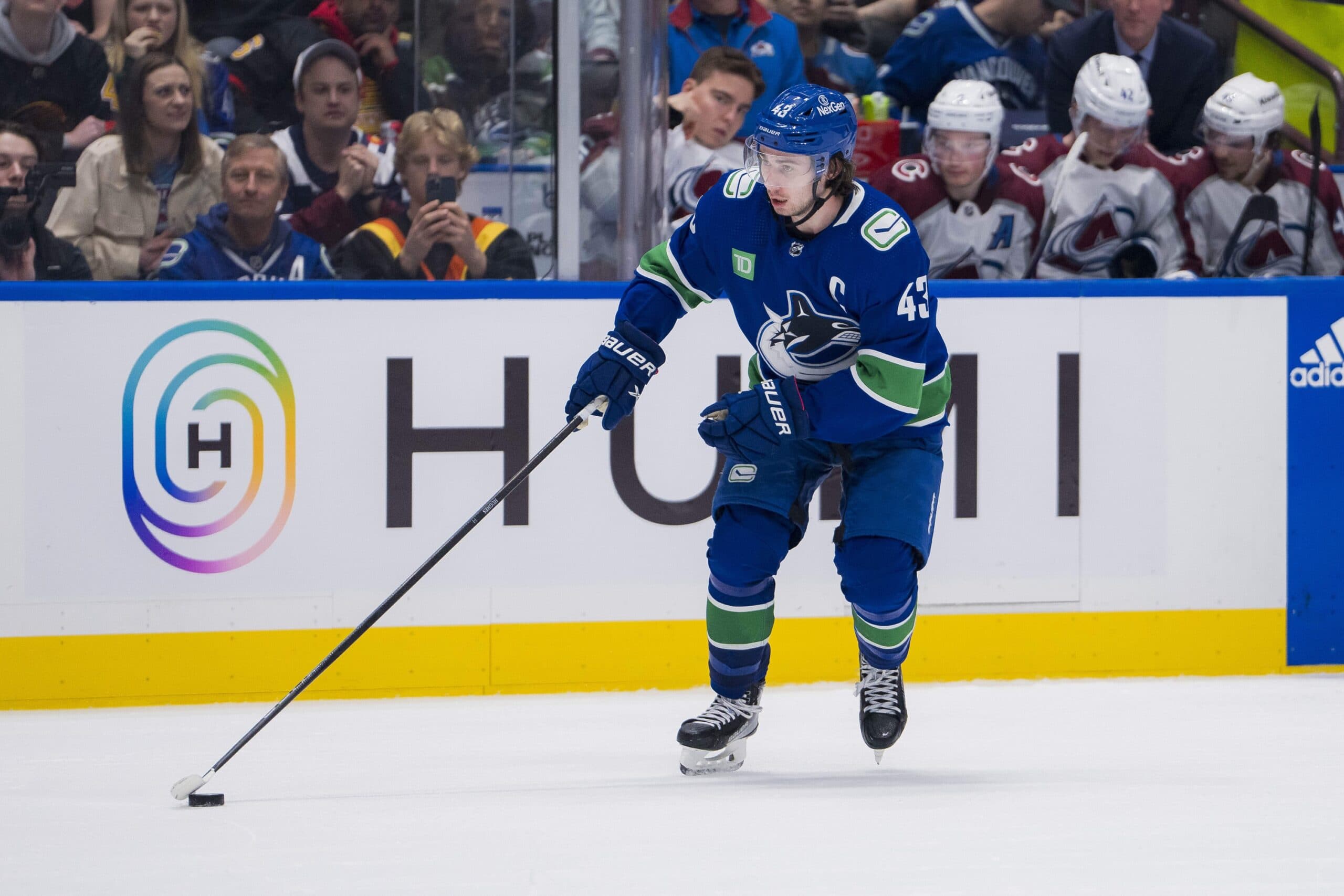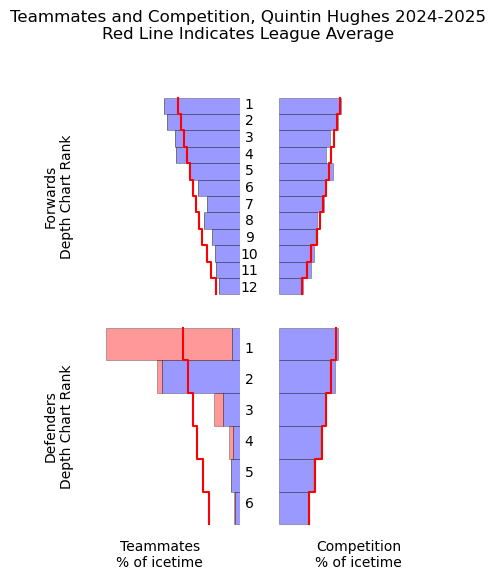Nation Sites
The Nation Network
CanucksArmy has no direct affiliation to the Vancouver Canucks, Canucks Sports & Entertainment, NHL, or NHLPA
Norris Trophy Race Update: Quinn Hughes is practically lapping Cale Makar right now

Photo credit: © Bob Frid-Imagn Images
Dec 13, 2024, 13:45 ESTUpdated: Dec 13, 2024, 18:41 EST
This past week, the NHL’s 2024/25 regular season hit the one-third mark, and that led to a number of articles checking in on the league’s progress thus far. Some folks talked about scoring leaders or the playoff picture, while others talked about the race for various NHL Awards.
You may or may not have caught wind of a couple of pieces written about the ongoing odds for the Norris Trophy, handed out each year to someone adjudicated to be the league’s top defender. Most prominent was a vote conducted by ESPN which, among other things, named Cale Makar of the Colorado Avalanche as the runaway favourite for the award.
According to the writeup, Makar received a whopping 75% of the votes. But should he have?
From where we’re sitting, not only should Quinn Hughes be receiving at least equal consideration at this point, but he should probably be lapping Makar in this so-called race.
It’s true that Makar got out to a very hot start on 2024/25. By his 13th game of the season, he’d notched his 23rd point. You’ll hear a lot of people start the ‘Makar for Norris’ talk by referencing his offensive dominance.
But that offensive dominance has slowed down considerably. After the 23 in 13 start, Makar scored just 13 points in the 18 games that followed.
Yes, that gives him a total of 36 points in 31 games, impressive by any standard and especially so from a blueliner. But impressive does not equate with dominant.
Following Hughes’ three-point showing against the Florida Panthers, he moved up to 34 points of his own in just 28 games played. If we’re going by point-per-game, Hughes has now surpassed Makar to the tune of 1.21 to 1.16. Any whereas Makar seems to be slowing down after a red-hot start, Hughes appears to only be heating up.
If we’re talking proportional offence, that also favours Hughes. The Avalanche have scored 101 goals on the season, with Makar in on 35.6% of them. The Canucks, as of this writing, have scored 92 goals on the season, with Hughes in on 37.0% of them.
Their ice-time is nearly identical, with Makar at 25:13 and Hughes at 24:56. Had Hughes not missed most of a game due to an ejection, or considerable time getting his face fixed after a recent high-stick, they’d probably be dead-even. In any case, this obviously gives Hughes a slightly higher per-60 scoring rate.
In terms of the by-strength breakdown, it’s also a dead heat at 20 even-strength points each, with Makar having one more power play and one more shorthanded point.
So, if Makar is considered the Norris favourite for primarily offensive reasons…he shouldn’t be considered the favourite, because Hughes is outperforming him offensively.
What about by other measures?
The myth of Hughes being anything less than an excellent defensive player has, thankfully, mostly died out by this point. In this regard, he also compares to Makar quite favourably.
If we’re talking just raw goals for versus against, Hughes has been on the ice for 40 even-strength goals for and 27 against, for a differential of +13, which is tied for eighth-best in the NHL. Makar, on the other hand, is at 35 goals for and 33 against, for a differential of just +2, which is tied for 88th-best in the NHL.
The word on the street has always been that Makar faces tougher competition and deployment than Hughes, and that could explain the discrepancy. Could, but doesn’t.
It’s true that Hughes starts more of his shifts and takes more faceoffs in the offensive zone than Makar. But it’s a difference of 64.67% for Hughes to 64.03% for Makar. Hardly a remarkable gap.
The quality of competition charts, as provided by HockeyViz, do show that Makar is facing a slightly higher QoC, in that he’s playing a higher percentage of his minutes against opposing top lines…


From HockeyViz.com
…but then that difference is dwarfed by the difference in quality of teammates, which heavily favours Makar. So, yes, Makar is out there against the best the opponents have to offer slightly more often than Hughes. But he’s also out there with the best his own team has to offer on a far more consistent basis.
Let’s break that concept down a little further.
Hughes has some talented teammates of his own. For the purposes of this exercise, we’re focusing on his two most talented: Elias Pettersson and JT Miller.
Hughes probably plays his best hockey when he’s out there with one of those two. But that doesn’t mean he slacks when he’s not. Without either of Pettersson or Miller on the ice at even-strength, Hughes’ stats still absolutely sparkle. We’re talking 16 goals for to 7 against, we’re talking a 58.41% Corsi, we’re talking a 57.59% control of scoring chances.
All without either of Pettersson or Miller out there with him.
How does Makar compare? We’ll focus on his two most talented teammates in Nathan MacKinnon and Mikko Rantanen – who, if you’ll recall the last chart, he plays with far more than Hughes plays with Pettersson and Miller.
Without MacKinnon and Rantanen on the ice, Makar’s stats…kind of suck. He’s at just two goals for and three against, which is a minus rating. He’s at a 41.55% Corsi and just a 48.11% control of scoring chances.
So, Hughes without Pettersson and Miller? Barely a noticeable difference. Makar without MacKinnon and Rantanen? Big, big difference, and not in the good way.
To sum all this up, Hughes has caught up to and surpassed Makar in the offensive sense. He’s playing just as well defensively, if not better. And he sure appears to be doing it all with less direct support from his teammates, whereas Makar seems to really be leaning on MacKinnon and Rantanen for his on-ice success.
Put it all together, and we’ve moved on from wondering how Makar is getting so much more hype for the Norris than Hughes to wondering why he’s getting any of it.
From our perspective, Hughes isn’t just winning the 2025 Norris Race, he’s now well out ahead of the competition, Makar and every other defender in the world included.
Sponsored by bet365
Breaking News
- The Stanchies: Conor Garland makes it interesting, but Canucks fall 6-3 to Sharks
- World Juniors: Canucks’ Cootes and Team Canada avoid upset loss, Sansonnens scores for Switzerland
- Instant Reaction: Home woes continue as Canucks fall 6-3 to Sharks
- Canucks: The pros and cons of the Quinn Hughes trade, two weeks later
- Scenes from morning skate: Pettersson returns, Demko starts for Canucks vs. Sharks
